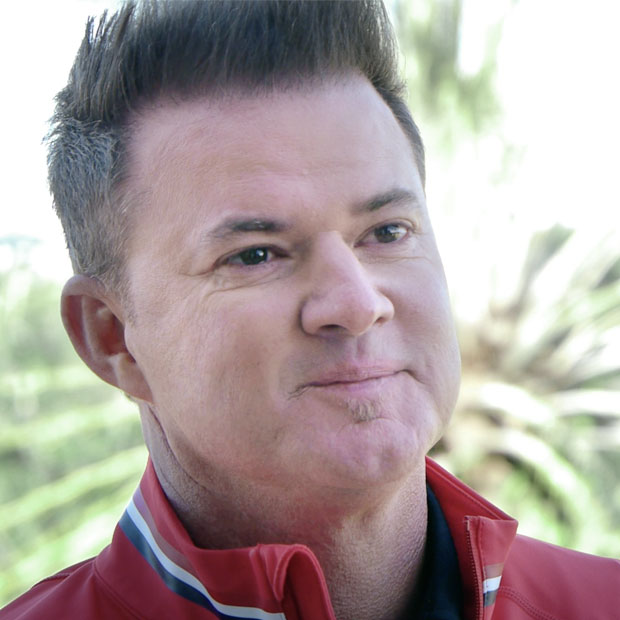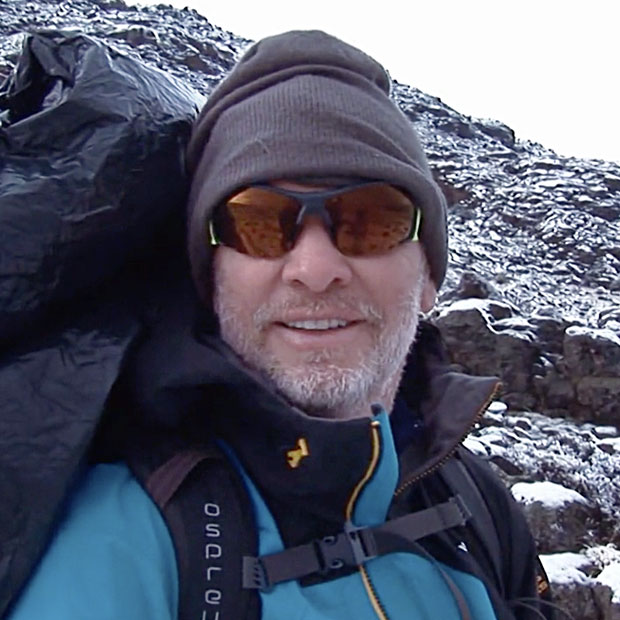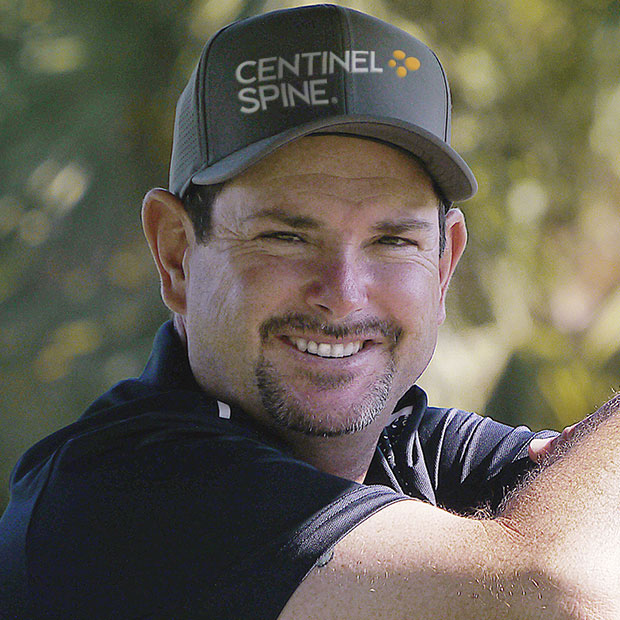| Abdomen | The section of the body located between the bottom of the rib cage and pelvis. |
| Acute | Immediate, severe or intense. |
| Annulus Fibrosus |
A circular structure that makes up the outer most portion of the intervertebral disc.
It is a sturdy, elastic fibrous structure that encompasses the gel-like nucleus pulposus. |
| Anterior | Located towards the front or forward to another object. Anterior refers to the front side of the human body. |
| Anterior Cervical Discectomy and Fusion (ACDF) |
A surgical procedure to remove and replace a degenerative disc in the cervical (neck) spine.
During the procedure, an incision is made in the front of the neck to access the anterior spine.
The diseased disc is removed and an interbody device is inserted between the two vertebrae,
supporting the spine while it heals forming a fusion. |
| Anterior Lumbar Interbody Fusion (ALIF) |
A surgical procedure to remove and replace a degenerative disc in the lumbar (lower back) spine.
During the procedure, an incision is made in the front of the body (abdomen) to access the anterior spine.
The diseased disc is removed and an interbody device is implanted between the two vertebrae,
supporting the spine while it heals forming a fusion. |
| Anterolateral | A surgical approach to the spine that is between the front (anterior) and the side (lateral). |
| Arthritis |
A disease of a joint in the body, including the facet joint of the spine, usually causing inflammation,
swelling and pain that may limit the motion of the joint. |
| Arthrodesis | A surgical procedure performed to prevent motion of a joint by fusing that joint. |
| Decompression |
A surgical procedure that removes the bone or disc material that is impinging upon or compressing a nerve to relieve pain and other symptoms. |
| Degenerative Disc Disease (DDD) |
Age related deterioration of the intervertebral discs, which are located between each vertebra of the spine. |
| Disc Herniation |
Also referred to as a slipped disc, a disc herniation happens when part of the nucleus pulposus
(inner portion of the disc) protrudes through the annulus fibrosus (outer layer of the disc). |
| Discectomy | A surgical procedure where an intervertebral disc is either partially or completely removed. |
| Dysphonia | A disorder affecting the throat or vocal cords causing difficulty speaking and/or hoarseness. |
| Dysphagia | A disorder affecting the throat, esophagus (stomach tube) or chest causing difficulty swallowing. |
| Facet |
A structure of the vertebra located at the back of the spine. A facet moves with the facet of the neighboring
vertebra to form a facet joint. This joint allows motion in the back or along the spinal column.
Each vertebra has two superior (above) and two inferior (below) facets. |
| Facet Joint |
A joint in the spine or back. There are two facet joints located at the back of each vertebra.
The facet joint moves with the vertebra above and the vertebra below to form a motion segment in the spine. |
| Facetectomy | Surgical removal of part or all of a facet joint. |
| Foramen |
A natural opening or space in the body. In the spine, a foramen is formed by a facet joint.
The nerves originating from the spine pass through the foramen to exit the spinal canal. |
| Foraminotomy |
A surgical procedure that opens the foramen by removing bone and other tissue to provide more space
for the exiting nerve root that maybe compressed or impinged. |
| Fracture | A break in a bone or bony structures. |
| Fusion |
A natural or mechanical joining or healing of two adjacent bone structures by the formation of new bone between the structures. |
| Iliac Bone |
A bone structure located in the pelvic region of the body. It is located above the hip joint and is connected to the sacrum.
It is the bone from which surgeons may remove bone graft material to use to promote healing or fusion in spinal surgical procedures. |
| Iliac Crest | A large protruding section of the iliac bone. It is commonly called the hip bone. |
| Ilium | The upper and largest region of the coxal bones of the pelvis. |
| Interbody Fusion |
A surgical procedure performed to remove the intervertebral disc, implant an interbody device,
and permanently join or fuse two or more vertebrae together. |
| Intervertebral Disc |
The structure located between each spinal vertebra that acts as a cushion or shock absorber for the spine.
The disc has a thick outer layer called the annulus fibrosus. The annulus fibrosus surrounds an inner gel like
substance called the nucleus pulposus. |
| Lamina |
Part of a vertebra that forms the arched covering or roof of the spinal canal. Each vertebra has two laminae that
connect the pedicles on each side of the spine to the spinous processes in the middle of the spine. |
| Laminectomy |
A surgical procedure performed to remove the lamina of a vertebra creating more room for the spinal
cord and associated nerves. A laminectomy may also be performed to create surgical access for a discectomy. |
| Laminotomy |
A surgical procedure removing part of one of the vertebral lamina creating room for the spinal cord and associated nerves. |
| Lateral |
Located towards or on the side of a structure or object. Lateral refers to the left or right side of the human body. |
| Lateral Lumbar Interbody Fusion (LLIF) |
A spinal fusion procedure where the intervertebral disc space is surgically accessed laterally from the patient’s side.
An LLIF procedure is performed to fuse two or more vertebrae in the lumbar spine |
| Lordosis |
A natural backward rounding of the back, found in the cervical and lumbar spine; some rounding is normal but lordosis
(also called swayback) generally refers to an exaggerated backward curvature of the lower (lumbar) spine where the spine curves
significantly inward at the lower back |
| Lumbar Spine |
The lower portion of the spine located in the abdominal region of the back. The lumbar spine is comprised of five vertebrae,
which are known as L1 to L5. |
| Neck Disability Index (NDI) |
A patient survey based upon the Oswestry Disability Index (ODI) that is used to measure neck pain.
The survey includes questions on pain, personal care, lifting, headaches, work, driving, sleeping and
other daily life activities. |
| Nerve |
Organic fibers that are comprised of nerve cells, which send messages between the brain and the rest of the body. |
| Nerve Compression | Impingement or pressure on a nerve that may cause damage, pain and weakness in another part of the body. |
| Nerve Root | The beginning or foundation of a nerve that is located at the spinal cord and passes through the spinal foramen. |
| Nerve Root Block | An injection of a local anesthetic that numbs a nerve believed to be causing arm or leg pain. |
| Nucleus Pulposus | The inner gel-like, elastic center of an intervertebral disc. |
| Sacroiliac Joint | The joint located between the sacrum and ilium. |
| Sacral Spine |
The lower most portion of the spine located between the lumbar spine and the coccyx bone.
The sacral spine is compromised of five vertebrae, which are known as S1 to S5. |
| Sacrum |
The lower-most portion of the spine located between the lumbar spine and the coccyx bone.
The sacral spine is comprised of five vertebrae, which are known as S1 to S5. |
| Sentinel Sign |
A radiographic bridging of bone anterior to a surgically implanted device in the spine.
It is visible in the shape of the letter ‘S’. This is where Centinel Spine derived its name. |
| SF-12 (Short-Form) | A twelve-question survey assessing a patient's quality of life. |
| Spine |
A flexible column of bone that extends from the base of the skull to the tailbone.
The spine is comprised of thirty-three bones called vertebrae.
The spine is also known as the vertebral column, spinal column, or backbone. |
| Spinal Canal |
The bony channel that runs through the spine containing and protecting the spinal cord and associated nerve roots.
The spinal canal is formed by the laminae and foramina of the spine. |
| Spinal Cord |
A bundle of nerves and related tissue that communicates messages and impulses to and from the brain and the rest of the body. |
| Spinal Fusion |
A surgical procedure performed to fuse two or more vertebrae thereby preventing movement at a spinal motion segment. |
| Spinal Motion Segment |
A structure in the spine that includes two neighboring vertebrae, the intervertebral disc that is located between the vertebrae,
the two facet joints located at the posterior sides of the segment and all the associated ligaments and tissues. |
| Spinous Process |
Part of the vertebrae that extends posteriorly from each vertebrae. The spinous processes are the “bumps” you can feel on your back. |
| Spinal Stenosis | A narrowing of the spinal canal. |
| Spondylolisthesis |
A medical condition where one vertebra slips or moves forward in relation to the vertebra located below it. |





